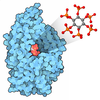+ Open data
Open data
- Basic information
Basic information
| Entry | Database: PDB / ID: 6kwy | |||||||||
|---|---|---|---|---|---|---|---|---|---|---|
| Title | human PA200-20S complex | |||||||||
 Components Components |
| |||||||||
 Keywords Keywords | HYDROLASE / proteasome activator | |||||||||
| Function / homology |  Function and homology information Function and homology informationspermatoproteasome complex / sperm DNA condensation / peptidase activator activity / purine ribonucleoside triphosphate binding / Regulation of ornithine decarboxylase (ODC) / Proteasome assembly / Cross-presentation of soluble exogenous antigens (endosomes) / proteasome core complex / Somitogenesis / proteasomal ubiquitin-independent protein catabolic process ...spermatoproteasome complex / sperm DNA condensation / peptidase activator activity / purine ribonucleoside triphosphate binding / Regulation of ornithine decarboxylase (ODC) / Proteasome assembly / Cross-presentation of soluble exogenous antigens (endosomes) / proteasome core complex / Somitogenesis / proteasomal ubiquitin-independent protein catabolic process / proteasome binding / myofibril / immune system process / NF-kappaB binding / proteasome endopeptidase complex / proteasome core complex, beta-subunit complex / proteasome assembly / threonine-type endopeptidase activity / proteasome core complex, alpha-subunit complex / : / proteasome complex / proteolysis involved in protein catabolic process / sarcomere / Regulation of activated PAK-2p34 by proteasome mediated degradation / Autodegradation of Cdh1 by Cdh1:APC/C / APC/C:Cdc20 mediated degradation of Securin / Asymmetric localization of PCP proteins / Ubiquitin-dependent degradation of Cyclin D / SCF-beta-TrCP mediated degradation of Emi1 / NIK-->noncanonical NF-kB signaling / TNFR2 non-canonical NF-kB pathway / AUF1 (hnRNP D0) binds and destabilizes mRNA / Vpu mediated degradation of CD4 / Assembly of the pre-replicative complex / Ubiquitin-Mediated Degradation of Phosphorylated Cdc25A / Degradation of DVL / Cdc20:Phospho-APC/C mediated degradation of Cyclin A / Dectin-1 mediated noncanonical NF-kB signaling / lipopolysaccharide binding / negative regulation of inflammatory response to antigenic stimulus / Degradation of AXIN / Hh mutants are degraded by ERAD / Activation of NF-kappaB in B cells / P-body / Degradation of GLI1 by the proteasome / Hedgehog ligand biogenesis / G2/M Checkpoints / Defective CFTR causes cystic fibrosis / GSK3B and BTRC:CUL1-mediated-degradation of NFE2L2 / Autodegradation of the E3 ubiquitin ligase COP1 / Negative regulation of NOTCH4 signaling / Vif-mediated degradation of APOBEC3G / Regulation of RUNX3 expression and activity / Hedgehog 'on' state / Degradation of GLI2 by the proteasome / GLI3 is processed to GLI3R by the proteasome / FBXL7 down-regulates AURKA during mitotic entry and in early mitosis / APC/C:Cdh1 mediated degradation of Cdc20 and other APC/C:Cdh1 targeted proteins in late mitosis/early G1 / MAPK6/MAPK4 signaling / Degradation of beta-catenin by the destruction complex / Oxygen-dependent proline hydroxylation of Hypoxia-inducible Factor Alpha / ABC-family proteins mediated transport / CDK-mediated phosphorylation and removal of Cdc6 / CLEC7A (Dectin-1) signaling / response to virus / SCF(Skp2)-mediated degradation of p27/p21 / FCERI mediated NF-kB activation / Regulation of expression of SLITs and ROBOs / nuclear matrix / Regulation of PTEN stability and activity / Interleukin-1 signaling / Orc1 removal from chromatin / Regulation of RAS by GAPs / Regulation of RUNX2 expression and activity / The role of GTSE1 in G2/M progression after G2 checkpoint / Separation of Sister Chromatids / UCH proteinases / KEAP1-NFE2L2 pathway / Antigen processing: Ubiquitination & Proteasome degradation / Downstream TCR signaling / peptidase activity / RUNX1 regulates transcription of genes involved in differentiation of HSCs / Neddylation / ER-Phagosome pathway / regulation of inflammatory response / secretory granule lumen / endopeptidase activity / proteasome-mediated ubiquitin-dependent protein catabolic process / response to oxidative stress / ficolin-1-rich granule lumen / positive regulation of canonical NF-kappaB signal transduction / Ub-specific processing proteases / nuclear speck / nuclear body / ciliary basal body / cilium / ribosome / cadherin binding / DNA repair / intracellular membrane-bounded organelle Similarity search - Function | |||||||||
| Biological species |  Homo sapiens (human) Homo sapiens (human) | |||||||||
| Method | ELECTRON MICROSCOPY / single particle reconstruction / cryo EM / Resolution: 2.72 Å | |||||||||
 Authors Authors | Ouyang, S. / Hongxin, G. | |||||||||
| Funding support |  China, 1items China, 1items
| |||||||||
 Citation Citation |  Journal: PLoS Biol / Year: 2020 Journal: PLoS Biol / Year: 2020Title: Cryo-EM structures of the human PA200 and PA200-20S complex reveal regulation of proteasome gate opening and two PA200 apertures. Authors: Hongxin Guan / Youwang Wang / Ting Yu / Yini Huang / Mianhuan Li / Abdullah F U H Saeed / Vanja Perčulija / Daliang Li / Jia Xiao / Dongmei Wang / Ping Zhu / Songying Ouyang /  Abstract: Proteasomes are highly abundant and conserved protease complexes that eliminate unwanted proteins in the cells. As a single-chain ATP-independent nuclear proteasome activator, proteasome activator ...Proteasomes are highly abundant and conserved protease complexes that eliminate unwanted proteins in the cells. As a single-chain ATP-independent nuclear proteasome activator, proteasome activator 200 (PA200) associates with 20S core particle to form proteasome complex that catalyzes polyubiquitin-independent degradation of acetylated histones, thus playing a pivotal role in DNA repair and spermatogenesis. Here, we present cryo-electron microscopy (cryo-EM) structures of the human PA200-20S complex and PA200 at 2.72 Å and 3.75 Å, respectively. PA200 exhibits a dome-like architecture that caps 20S and uses its C-terminal YYA (Tyr-Tyr-Ala) to induce the α-ring rearrangements and partial opening of the 20S gate. Our structural data also indicate that PA200 has two openings formed by numerous positively charged residues that respectively bind (5,6)-bisdiphosphoinositol tetrakisphosphate (5,6[PP]2-InsP4) and inositol hexakisphosphate (InsP6) and are likely to be the gates that lead unfolded proteins through PA200 and into the 20S. Besides, our structural analysis of PA200 found that the bromodomain (BRD)-like (BRDL) domain of PA200 shows considerable sequence variation in comparison to other human BRDs, as it contains only 82 residues because of a short ZA loop, and cannot be classified into any of the eight typical human BRD families. Taken together, the results obtained from this study provide important insights into human PA200-induced 20S gate opening for substrate degradation and the opportunities to explore the mechanism for its recognition of H4 histone in acetylation-mediated proteasomal degradation. | |||||||||
| History |
|
- Structure visualization
Structure visualization
| Movie |
 Movie viewer Movie viewer |
|---|---|
| Structure viewer | Molecule:  Molmil Molmil Jmol/JSmol Jmol/JSmol |
- Downloads & links
Downloads & links
- Download
Download
| PDBx/mmCIF format |  6kwy.cif.gz 6kwy.cif.gz | 1.7 MB | Display |  PDBx/mmCIF format PDBx/mmCIF format |
|---|---|---|---|---|
| PDB format |  pdb6kwy.ent.gz pdb6kwy.ent.gz | 1.3 MB | Display |  PDB format PDB format |
| PDBx/mmJSON format |  6kwy.json.gz 6kwy.json.gz | Tree view |  PDBx/mmJSON format PDBx/mmJSON format | |
| Others |  Other downloads Other downloads |
-Validation report
| Summary document |  6kwy_validation.pdf.gz 6kwy_validation.pdf.gz | 1.2 MB | Display |  wwPDB validaton report wwPDB validaton report |
|---|---|---|---|---|
| Full document |  6kwy_full_validation.pdf.gz 6kwy_full_validation.pdf.gz | 1.2 MB | Display | |
| Data in XML |  6kwy_validation.xml.gz 6kwy_validation.xml.gz | 183.2 KB | Display | |
| Data in CIF |  6kwy_validation.cif.gz 6kwy_validation.cif.gz | 296.8 KB | Display | |
| Arichive directory |  https://data.pdbj.org/pub/pdb/validation_reports/kw/6kwy https://data.pdbj.org/pub/pdb/validation_reports/kw/6kwy ftp://data.pdbj.org/pub/pdb/validation_reports/kw/6kwy ftp://data.pdbj.org/pub/pdb/validation_reports/kw/6kwy | HTTPS FTP |
-Related structure data
| Related structure data |  0781MC  0780C  6kwxC C: citing same article ( M: map data used to model this data |
|---|---|
| Similar structure data |
- Links
Links
- Assembly
Assembly
| Deposited unit | 
|
|---|---|
| 1 |
|
- Components
Components
-Proteasome subunit alpha type- ... , 7 types, 14 molecules AOBPCQDRESFTGU
| #1: Protein | Mass: 25927.535 Da / Num. of mol.: 2 Source method: isolated from a genetically manipulated source Source: (gene. exp.)  Homo sapiens (human) / Gene: PSMA2, HC3, PSC3 / Production host: Homo sapiens (human) / Gene: PSMA2, HC3, PSC3 / Production host:  Homo sapiens (human) Homo sapiens (human)References: UniProt: P25787, proteasome endopeptidase complex #2: Protein | Mass: 29525.842 Da / Num. of mol.: 2 Source method: isolated from a genetically manipulated source Source: (gene. exp.)  Homo sapiens (human) / Gene: PSMA4, HC9, PSC9 / Production host: Homo sapiens (human) / Gene: PSMA4, HC9, PSC9 / Production host:  Homo sapiens (human) Homo sapiens (human)References: UniProt: P25789, proteasome endopeptidase complex #3: Protein | Mass: 27929.891 Da / Num. of mol.: 2 Source method: isolated from a genetically manipulated source Source: (gene. exp.)  Homo sapiens (human) / Gene: PSMA7, HSPC / Production host: Homo sapiens (human) / Gene: PSMA7, HSPC / Production host:  Homo sapiens (human) Homo sapiens (human)References: UniProt: O14818, proteasome endopeptidase complex #4: Protein | Mass: 26435.977 Da / Num. of mol.: 2 Source method: isolated from a genetically manipulated source Source: (gene. exp.)  Homo sapiens (human) / Gene: PSMA5 / Production host: Homo sapiens (human) / Gene: PSMA5 / Production host:  Homo sapiens (human) Homo sapiens (human)References: UniProt: P28066, proteasome endopeptidase complex #5: Protein | Mass: 29595.627 Da / Num. of mol.: 2 Source method: isolated from a genetically manipulated source Source: (gene. exp.)  Homo sapiens (human) / Gene: PSMA1, HC2, NU, PROS30, PSC2 / Production host: Homo sapiens (human) / Gene: PSMA1, HC2, NU, PROS30, PSC2 / Production host:  Homo sapiens (human) Homo sapiens (human)References: UniProt: P25786, proteasome endopeptidase complex #6: Protein | Mass: 28469.252 Da / Num. of mol.: 2 Source method: isolated from a genetically manipulated source Source: (gene. exp.)  Homo sapiens (human) / Gene: PSMA3, HC8, PSC8 / Production host: Homo sapiens (human) / Gene: PSMA3, HC8, PSC8 / Production host:  Homo sapiens (human) Homo sapiens (human)References: UniProt: P25788, proteasome endopeptidase complex #7: Protein | Mass: 27432.459 Da / Num. of mol.: 2 Source method: isolated from a genetically manipulated source Source: (gene. exp.)  Homo sapiens (human) / Gene: PSMA6, PROS27 / Production host: Homo sapiens (human) / Gene: PSMA6, PROS27 / Production host:  Homo sapiens (human) Homo sapiens (human)References: UniProt: P60900, proteasome endopeptidase complex |
|---|
-Proteasome subunit beta type- ... , 7 types, 14 molecules HVIWJXKYLZMaNb
| #8: Protein | Mass: 30000.418 Da / Num. of mol.: 2 Source method: isolated from a genetically manipulated source Source: (gene. exp.)  Homo sapiens (human) / Gene: PSMB7, Z / Production host: Homo sapiens (human) / Gene: PSMB7, Z / Production host:  Homo sapiens (human) Homo sapiens (human)References: UniProt: Q99436, proteasome endopeptidase complex #9: Protein | Mass: 22972.896 Da / Num. of mol.: 2 Source method: isolated from a genetically manipulated source Source: (gene. exp.)  Homo sapiens (human) / Gene: PSMB3 / Production host: Homo sapiens (human) / Gene: PSMB3 / Production host:  Homo sapiens (human) Homo sapiens (human)References: UniProt: P49720, proteasome endopeptidase complex #10: Protein | Mass: 22864.277 Da / Num. of mol.: 2 Source method: isolated from a genetically manipulated source Source: (gene. exp.)  Homo sapiens (human) / Gene: PSMB2 / Production host: Homo sapiens (human) / Gene: PSMB2 / Production host:  Homo sapiens (human) Homo sapiens (human)References: UniProt: P49721, proteasome endopeptidase complex #11: Protein | Mass: 28510.248 Da / Num. of mol.: 2 Source method: isolated from a genetically manipulated source Source: (gene. exp.)  Homo sapiens (human) / Gene: PSMB5, LMPX, MB1, X / Production host: Homo sapiens (human) / Gene: PSMB5, LMPX, MB1, X / Production host:  Homo sapiens (human) Homo sapiens (human)References: UniProt: P28074, proteasome endopeptidase complex #12: Protein | Mass: 26522.396 Da / Num. of mol.: 2 Source method: isolated from a genetically manipulated source Source: (gene. exp.)  Homo sapiens (human) / Gene: PSMB1, PSC5 / Production host: Homo sapiens (human) / Gene: PSMB1, PSC5 / Production host:  Homo sapiens (human) Homo sapiens (human)References: UniProt: P20618, proteasome endopeptidase complex #13: Protein | Mass: 29231.178 Da / Num. of mol.: 2 Source method: isolated from a genetically manipulated source Source: (gene. exp.)  Homo sapiens (human) / Gene: PSMB4, PROS26 / Production host: Homo sapiens (human) / Gene: PSMB4, PROS26 / Production host:  Homo sapiens (human) Homo sapiens (human)References: UniProt: P28070, proteasome endopeptidase complex #14: Protein | Mass: 25377.652 Da / Num. of mol.: 2 Source method: isolated from a genetically manipulated source Source: (gene. exp.)  Homo sapiens (human) / Gene: PSMB6, LMPY, Y / Production host: Homo sapiens (human) / Gene: PSMB6, LMPY, Y / Production host:  Homo sapiens (human) Homo sapiens (human)References: UniProt: P28072, proteasome endopeptidase complex |
|---|
-Protein , 1 types, 1 molecules c
| #15: Protein | Mass: 215774.875 Da / Num. of mol.: 1 Source method: isolated from a genetically manipulated source Source: (gene. exp.)  Homo sapiens (human) / Gene: PSME4, KIAA0077 / Production host: Homo sapiens (human) / Gene: PSME4, KIAA0077 / Production host:  Homo sapiens (human) / References: UniProt: Q14997 Homo sapiens (human) / References: UniProt: Q14997 |
|---|
-Non-polymers , 2 types, 2 molecules 
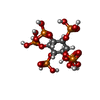

| #16: Chemical | ChemComp-K0W / [( |
|---|---|
| #17: Chemical | ChemComp-IHP / |
-Details
| Has ligand of interest | Y |
|---|
-Experimental details
-Experiment
| Experiment | Method: ELECTRON MICROSCOPY |
|---|---|
| EM experiment | Aggregation state: PARTICLE / 3D reconstruction method: single particle reconstruction |
- Sample preparation
Sample preparation
| Component | Name: complex of human PA200-20S / Type: CELL / Entity ID: #1-#15 / Source: RECOMBINANT |
|---|---|
| Source (natural) | Organism:  Homo sapiens (human) Homo sapiens (human) |
| Source (recombinant) | Organism:  Homo sapiens (human) Homo sapiens (human) |
| Buffer solution | pH: 7.5 |
| Specimen | Embedding applied: NO / Shadowing applied: NO / Staining applied: NO / Vitrification applied: YES |
| Vitrification | Cryogen name: ETHANE |
- Electron microscopy imaging
Electron microscopy imaging
| Experimental equipment |  Model: Titan Krios / Image courtesy: FEI Company |
|---|---|
| Microscopy | Model: FEI TITAN KRIOS |
| Electron gun | Electron source:  FIELD EMISSION GUN / Accelerating voltage: 300 kV / Illumination mode: OTHER FIELD EMISSION GUN / Accelerating voltage: 300 kV / Illumination mode: OTHER |
| Electron lens | Mode: BRIGHT FIELD |
| Image recording | Electron dose: 60 e/Å2 / Film or detector model: GATAN K2 SUMMIT (4k x 4k) |
- Processing
Processing
| CTF correction | Type: NONE |
|---|---|
| 3D reconstruction | Resolution: 2.72 Å / Resolution method: FSC 0.143 CUT-OFF / Num. of particles: 87000 / Symmetry type: POINT |
 Movie
Movie Controller
Controller



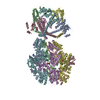
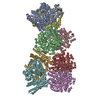
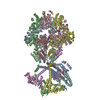
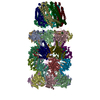
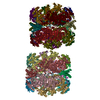

 PDBj
PDBj




